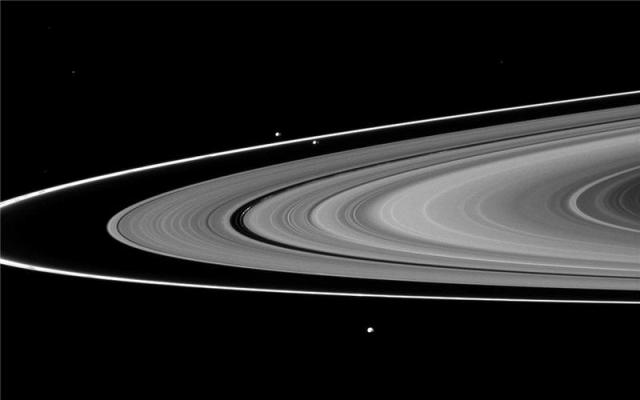Aug 24 2015
HYODO Ryuki, a second-year student in the Doctoral Program, and Professor OHTSUKI Keiji of the Graduate School of Science at Kobe University have revealed that Saturn’s F ring and its shepherd satellites are natural outcome of the final stage of formation of Saturn’s satellite system. Their finding has been published online in Nature Geoscience on August 17.
 Figure 1: Images of Saturn’s Main Rings, the F Ring, and its Shepherd Satellites Obtained by Cassini /The narrow F ring located just outside of the outer edge of the main rings. Two satellites sandwiching the F ring slightly above and to the left of the center of the image are the shepherd satellites Prometheus (inner orbit) and Pandora (outer orbit) (NASA/PIA12717)
Figure 1: Images of Saturn’s Main Rings, the F Ring, and its Shepherd Satellites Obtained by Cassini /The narrow F ring located just outside of the outer edge of the main rings. Two satellites sandwiching the F ring slightly above and to the left of the center of the image are the shepherd satellites Prometheus (inner orbit) and Pandora (outer orbit) (NASA/PIA12717)
Saturn, which is the second largest planet in our solar system, is known to have multiple rings and satellites. In 1979, Pioneer 11 discovered the F ring located just outside the main ring system that extends tens of thousands of kilometers. The F ring is very narrow with a width of only a few hundred kilometers, and has two shepherd satellites called Prometheus and Pandora, which orbit inside and outside the ring, respectively. Although the Voyager and Cassini spacecraft later made detailed observations of the F ring and its shepherd satellites, their origin has not been clarified.
According to the latest satellite formation theory, Saturn used to have ancient rings containing many more particles than they do today, and satellites formed from spreading and accretion of these particles. During the final stage of satellite formation, multiple small satellites tend to form near the outer edge of the ring. On the other hand, observations by Cassini indicate that the small satellites orbiting near the outer edge of the main ring system have a dense core. In their simulations using in part computer systems at the National Astronomical Observatory of Japan, HYODO and OHTSUKI revealed that the F ring and its shepherd satellites formed as these small satellites with a dense core collided and partially disintegrated. In other words, the system of the F ring and its shepherd satellites is a natural outcome of the formation process of Saturn’s ring-satellite system.
This new finding is expected to help elucidate the formation of satellite systems both within and outside our solar system. For example, the above formation mechanism can also be applied to the rings and shepherd satellites of Uranus, which are similar to those of Saturn.
HYODO, now visiting Institut de Physique du Globe de Paris for his research from this spring (April 2015) remarked, “Through this study, we were able to show that the current rings of Saturn reflect the formation and evolution processes of the planet’s satellite system.”
“As plans are underway in and outside of Japan to explore the satellite system of Jupiter and the satellites of Mars,” said OHTSUKI, “we will continue to unravel the origin of satellite systems, which is key to understanding the formation process of planetary systems.”